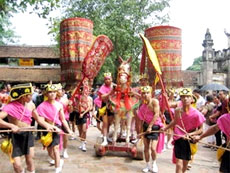The Saint Giong Festival in Vietnam’s Phu Dong and Soc Son Temples was recognised by the UNESCO as one of humankind’s representative intangible cultural heritage in Nairobi, Kenya on November 16.

This is Hanoi’s third cultural heritage certification honoured by the UNESCO in 2010. Earlier, 82 doctor steles at Van Mieu-Quoc Tu Giam (the Temple of Literature) were recognised as documentary heritage of the “Memory of the World†Programme and the relic site of the Thang Long Royal Citadel was recognised as a world cultural heritage site.
This year, the UNESCO has received 147 heritage files from 32 countries among the 113 member countries. At the November 16 session in Nairobi, the UNESCO Inter-Governmental Committee put 46 intangible cultural heritages from 29 nations onto the representative intangible cultural list, including Vietnam’s Saint Giong Festival.
212 representative intangible cultural heritages have been adopted by UNESCO and Vietnam has a number of heritages on this list, including the Hue Royal Court Music, the cultural space of gong in Tay Nguyen (Central Highlands), Ca Tru and the Bac Ninh folk songs, and now the Saint Giong Festival.
The Saint Giong Festival is a unique traditional event in Vietnam, held annually from the 6th-12th of the fourth lunar month in many places in Vietnam to commemorate the legendary national hero who grew from a 3-year-old child into a giant overnight to help drive out invaders from the country.
The 9th of the fourth lunar month is the major day for the biggest Saint Giong Festival at Phu Dong Village in Gia Lam District of Hanoi where this national hero was born.
The festival gives visitors a chance to travel Vietnam and watch the performance of traditional rituals and artistic activities, which have been handed down from generations to generations.